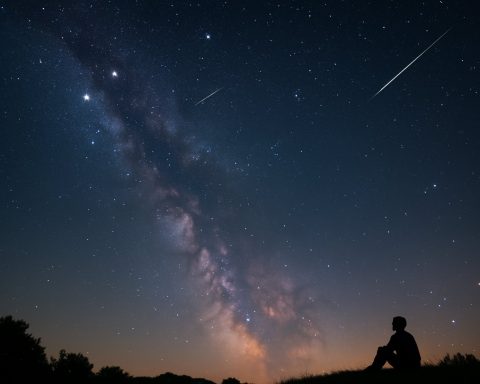- RCW 38, within the constellation of Vela, is revealed by VISTA’s VIRCAM camera as a richly detailed star cluster, located 13,000 light-years from Earth.
- This cosmic nursery hosts approximately 2,000 young stars, less than a million years old, surrounded by glowing gas and cosmic dust.
- The cluster’s luminous pink glow highlights the activity of energetic and massive stars, contrasting with the cooler dust shadows.
- RCW 38’s stars, in stark contrast to our older Sun, are characterized by their youth and energy, contributing to the cluster’s radiant aura.
- VISTA’s infrared capabilities penetrate cosmic dust, unveiling hidden stars and brown dwarfs, expanding our understanding of the universe.
- Observations of RCW 38 illustrate how advanced infrared technology can reveal the vivid stories and hidden structures within stellar clusters.
Amidst the silent stretches of the cosmos, a dazzling tableau unfurls in the constellation of Vela. An 80-million-pixel masterpiece, crafted by VISTA’s VIRCAM camera, unveils the youngest and densest of star clusters within 13,000 light-years of our Sun. This cosmic nursery, named RCW 38, lies shrouded in a celestial mist, its luminous newborn stars setting the surrounding gases aglow.
RCW 38 teems with life, less than a million years in age. It brims with around 2,000 nascent stars swathed in an envelope of glowing gas and cosmic dust. These are not stars you see every day; they are young, hot, and massive, many yet to shed their dusty veils and emerge into visibility. Here, the stark contrast between the radiant pink gas and the cooler, shadowy cosmic dust paints an almost psychedelic scene.
In contrast to our tranquil, middle-aged Sun, RCW 38’s burgeoning stars are like fierce youths. These burgeoning stars, bursting with energy, drive the cluster’s radiant aura. The intense glow isn’t just an optical illusion but a testament to the raw power coursing through this stellar womb, igniting the gases and casting a vibrant pink glow across the universe.
Thanks to VISTA’s infrared prowess, RCW 38 unveils its hidden secrets. This remarkable capability pierces through the cosmic dust, illuminating the previously hidden stars and even unveiling the elusive brown dwarfs — the ‘failed’ stars of the universe.
The survey of RCW 38 is a science fiction brought to life, reminding us that amidst the cosmic dust and gas lie treasures that infrared eyes can expose, redefining how we perceive the universe. As our gaze stretches beyond the night sky, we uncover the vivid stories of the stars, held within these stellar gatherings.
Unveiling the Mysteries: Inside Vela’s Stellar Nursery
Understanding the Cosmic Nursery of RCW 38
Features & Specifications
RCW 38 is a young, dense star cluster located approximately 13,000 light-years away in the constellation of Vela. It contains around 2,000 stars and is less than a million years old. The massive VISTA telescope, equipped with the VIRCAM camera, captures its magnificence. VIRCAM, aka the VISTA InfraRed CAMera, boasts an 80-million-pixel capability, vital in observing this celestial marvel.
Infrared Astronomy at Its Best
RCW 38 exemplifies infrared astronomy’s importance, as its stars are enveloped by cosmic dust, rendering them nearly invisible in visible light. Infrared observations, such as those conducted by VISTA, allow astronomers to slice through the dusty veils and illuminate the cluster’s hidden stars and brown dwarfs.
Why Is RCW 38 Significant in Astronomy?
Real-World Use Cases
– Star Formation Research: RCW 38 serves as a natural laboratory for studying the processes of star formation, critical to understanding how stars, like our Sun, and planetary systems come to be.
– Infrared Technology Validation: Demonstrating the capabilities of modern telescopes and cameras in piercing dense cosmic dust.
Market Forecasts & Industry Trends
The field of infrared astronomy is expanding, with market analysts projecting robust growth due to innovations in camera and telescope technology. The advancement of space telescopes, such as the James Webb Space Telescope, will further push the boundaries of what’s visible in the universe.
Reviews & Comparisons
When compared to other star clusters, RCW 38’s youthful, dynamic environment offers unique scientific opportunities. Its proximity and age make it especially valuable in contrast to older clusters, like the Pleiades.
Controversies & Limitations
Controversies
Some critiques revolve around the allocation of observational time on expensive telescopes like VISTA. As technology rapidly evolves, prioritizing targets becomes a debated topic in the astronomical community.
Limitations
The primary challenge in studying RCW 38 is its distance and the sheer amount of intervening cosmic dust. Even with sophisticated infrared instruments, certain intricacies still remain elusive.
Security & Sustainability in Astronomy
Sustainability Concerns
Astronomy faces sustainability challenges, largely in the realm of light pollution and energy consumption of observatories. Global initiatives aim to reduce light pollution to ensure the long-term viability of optical and infrared observations.
Future Insights & Predictions
As research continues, we anticipate discovering:
– New Planetary Systems: Further infrared surveys of RCW 38 may reveal nascent planetary systems forming around young stars.
– Star Formation Dynamics: Ongoing studies could offer insights into how massive stars influence their surroundings compared to more temperate stars like our Sun.
Actionable Tips for Aspiring Astronomers
– Get Familiar with Infrared Astronomy: Understanding the basics can significantly enhance your comprehension of modern astronomy.
– Follow Cutting-Edge Research: Stay updated with publications from leading space observatories and telescopes to understand current trends.
– Engage in Citizen Science: Platforms like Zooniverse offer opportunities to contribute to real-world astronomy projects.
By embracing these insights, we gain a deeper appreciation of the universe’s mysteries and the technological advancements unveiling them. Whether you are a stargazer, amateur enthusiast, or budding scientist, the cosmos holds a canvas of wonders to uncover.
Explore more at ESO or the NASA websites for a journey through the stars.









